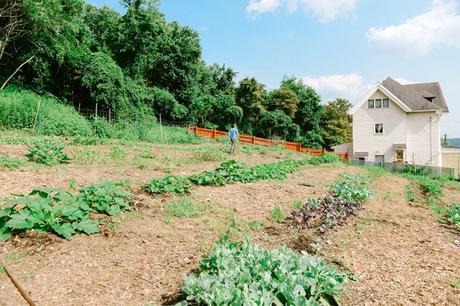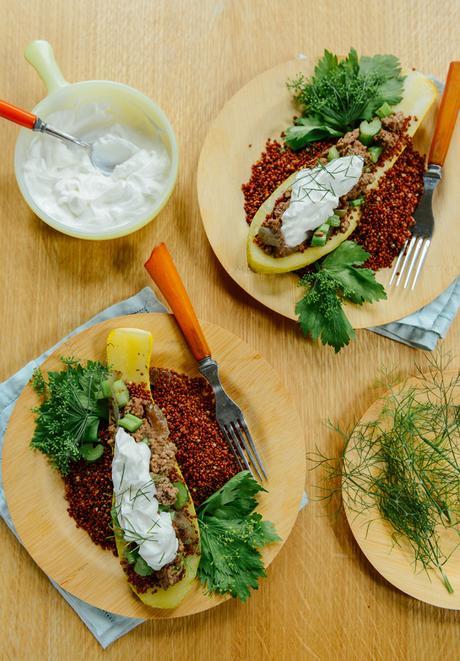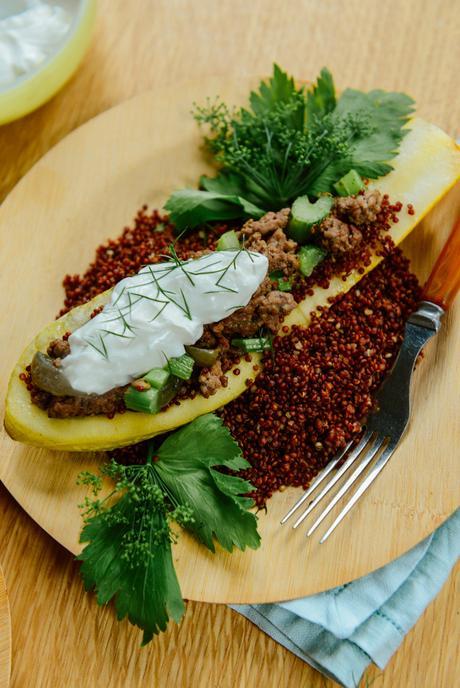There’s so much to learn about these foods we eat: what they look like as seeds, how they first sprout through the ground, how their leaves change during their infancy, how they put so much energy into a beautiful bloom and then attempt to spread their seeds. Carrot seeds are tiny and iridescent. Okra leaves boast dark, burgundy veins and patterns. Rainbow chard just keeps on giving. Cilantro flowers could fill a bouquet subtly, much like baby’s breath, while squash blossoms would sing dramatically but for a fleeting moment.

I’ve only just begun to understand the connections between flowers and the foods we eat, how we often have to sacrifice the alluring blooms in order to arrive at the food on our plates. The Urban Farmer plucked the first crepe-paper-like squash blossoms to conserve the plant’s energy for food production. As the broad, leafy greens emerged like a tropical forest cover, the female blooms grew again and gave way to the crookneck squashes. Those first signs of yellow and green meant the flood gates had been released. Summer squashes are in full swing, and there’s no looking back!

The Urban Farmer’s CSA recipients have received three weeks of crookneck squashes. If you frequent your local farmer’s market, you too have probably begun to see squashes and zucchinis, growing larger by the week. Once these gourds start, they don’t seem to stop, so it’s time to be creative, lest we be bored by the bounty.

I like to imagine eating these squash boats by the glassy blue Mediterranean Sea, where the adjacent cliffs are speckled with the white, building-block homes, where old grandmas prepare traditional meals for hours. These squash boats are merely an interpretation of that distant cuisine, a way to savor the fragrant dill, its flowers and dollops of thick, tangy Greek yogurt.

For this dish to taste its best, be sure to find local celery, local dill and local squashes (or zucchinis). Once you take a bite of crisp, locally grown celery, the store-bought version seems like eating a rice cake when you could be feasting on a pastry! The celery greens not only make a fanciful garnish, but they add a lot of flavor too. Chop them up and mix them into each bite. Take advantage of the here and now of squashes, herbs and stalky greens. Let your mind wander to the seaside, to summer breezes, to the bluest blues above the mountains and to the glassy waves washing onto your toes.

Bon voyage & Bon Appétit!
-Quelcy
Roasted Crookneck Squash with Quinoa, Lamb & Greek Yogurt
About This Recipe: Spelled out, this recipe looks complicated, but let the above images be your guide. Now is the time when squash flows, so take advantage and tweak this recipe several different ways. Use a zucchini instead of squash, or brown rice instead of quinoa. The idea is flexible. I used lamb because I was dreaming of Greek food, but you could use ground beef or chicken or even a seafood option.
Roasted Crookneck Squash with Quinoa, Lamb & Greek Yogurt
serves two
Roasted crookneck squash halves (recipe below)
Quinoa (recipe below)
Ground lamb with caramelized onion & celery (recipe below)
Greek Yogurt (such as Fage full-fat Greek yogurt)
Fresh Dill
Fresh Dill Flowers & Celery Greens for Garnish
To Assemble
Scoop a base of quinoa on the plate. Top with the squash half. Add a spoonful or two of quinoa to the squash surface, followed by the lamb mixture. Top with a dollop of Greek yogurt and fresh dill. Garnish with celery greens and dill flowers.
Roasted Crookneck Squash
Ingredients
1 medium sized crookneck squash (or zucchini)
2-3 Tablespoons organic butter
water
Directions
Preheat the oven to 425°F.
Cut off the stem of the squash. Slice the squash into two, long halves. Use a spoon to scoop out the seeds. Use a fork to poke the surface of the squash halves several times.
Add water to a cast iron skillet, until the water level is about ¼ inch up the side of the pan. This will help to steam the squash as it roasts. Place the two halves of the squash in the pan, face up. Add a Tablespoon or two of butter to the top of each squash half.
Place the skillet in the oven, and roast for 20-25 minutes, until the squash is tender, and the sides are lightly browned.
While the squash is roasting, prepare the lamb and the quinoa.
Lamb & Caramelized Onions
Ingredients
2-3 Tablespoons organic, unsalted butter
1 small red onion, peeled and sliced
1 lb ground lamb
2-3 stalks local celery plus celery greens
salt & pepper
Directions
Add the butter to a large skillet, or thick-bottomed pan. Heat the pan on medium-high heat until the butter is melted. Add the onion slices, and stir to coat the onions with the butter.
Spread the onions out evenly over the pan and let cook, stirring occasionally. Reduce heat to medium or medium low if the onions start to burn. As they cook, add water, in half cup increments, to prevent the onions from drying out.
As the onion begins to soften (after about 10 minutes), add the ground lamb, stirring to combine and to heat evenly.
Once the meat is browned, turn off the heat, and add the celery. Stir to combine, until the celery is softened slightly. Remove from heat. Salt and pepper to taste.
Quinoa
Ingredients
1 cup uncooked quinoa (any variety — white or golden, red, or black)
2 cups water or broth
1/2 teaspoon salt
Directions
Measure 1 cup of quinoa and place into a fine-mesh strainer. Rinse thoroughly with cool water for about 2 minutes. Rub and swish the quinoa with your hand while rinsing. Drain.
Add quinoa and liquid to a saucepan, and bring to a boil. Turn heat down to the lowest setting. Cover and cook for 15 minutes.
Remove the pot from heat and let stand for 5 more minutes, covered.
Remove the lid. Fluff the quinoa gently with a fork. If any liquid remains in the bottom of the pan or if the quinoa is still a bit crunchy, return the pot to low heat and cook, covered, for another 5 minutes, until all the water has been absorbed.
Enjoy!

